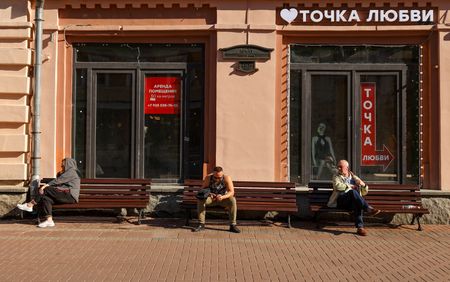By Alexander Marrow
MOSCOW (Reuters) – Russia will keep interest rates on hold for a few months before resuming monetary easing midway through next year, a Reuters poll suggested on Thursday, as the country battles high inflation and faces the threat of more economic sanctions.
Russia’s economic landscape changed drastically after Moscow sent tens of thousands of troops into Ukraine on Feb. 24, triggering sweeping Western curbs on its energy and financial sectors, including a partial freeze of Russian reserves, and prompting scores of foreign companies to exit the market.
The central bank last week ended a months-long rate-cutting cycle that followed an emergency rate hike to 20% from 9.5% in late February aimed at mitigating risks to financial stability.
Officials, economists and analysts have gradually been improving their forecasts for Russia’s economic prospects, since predictions of a double-digit economic contraction soon after the conflict began, but there are signs that President Vladimir Putin’s “partial mobilisation” drive may weigh.
The average forecast among 14 analysts polled in early November suggested the Russian economy was on track to shrink by 3.5% this year. A similar poll in September had predicted a contraction of 3.2%.
The central bank has said Moscow’s call-up of 300,000 reservists to fight in Ukraine could sap demand in the Russian economy, induce labour shortages and hurt consumer confidence.
Data published this week show a deeper contraction in retail sales in September, while businesses have seen sharp drops in employment.
“We believe that a strong rouble and the economic slowdown will keep inflation in the 12-13% range until the end of the year,” said Mikhail Vasilyev, chief analyst at Sovcombank, expecting rate cuts to resume as inflation slows.
The rouble has soared, supported by capital controls Moscow introduced to shield its financial system from sanctions, as well as Russia’s strong current account surplus due to high prices for commodity exports and falling imports.
But the currency is seen weakening in the coming months, and is expected to trade at 70.00 against the dollar a year from now, stronger though than a rate of 77.50 predicted by analysts in late September. Thursday’s official rate was 61.62 roubles per dollar.
“Some pressure on the rouble could come from a gradual increase in imports as logistical routes are found and a possible decline in exports against the backdrop of the EU’s oil embargo that comes into force in December and the G7’s price ceiling on Russian oil,” said Mikhail Poddubskiy, asset manager at MKB Investments.
Inflation, one of the key concerns among Russian households, is expected to accelerate to 12.5%, from 8.4% in 2021, according to the poll, marginally above September’s expectations of a 12.4% annual consumer prices increase.
In January, before the conflict in Ukraine began, analysts had on average expected the economy to grow by 2.5% with year-end inflation at 5.5%. Russia targets inflation at 4%.
(Reporting by Alexander Marrow and Elena Fabrichnaya; Editing by Tomasz Janowski)

